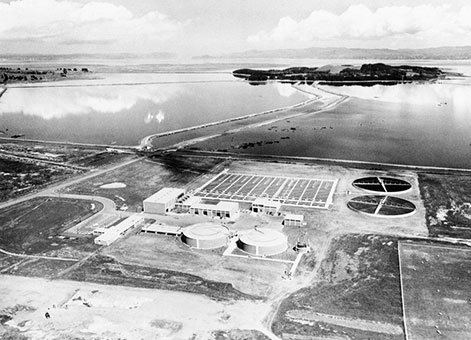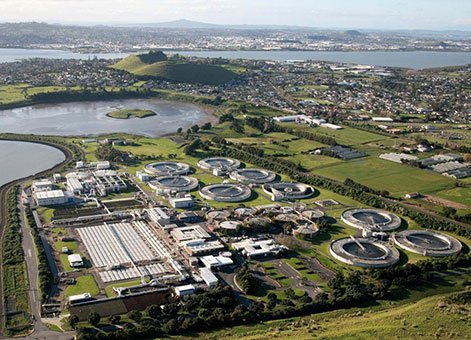Sewage disposal in Auckland has been a controversial topic over many years. Originally, holding tanks (now Kelly Tarlton’s Underwater World) were built at Okahu Bay in 1914, with sewage being released into the Waitemata Harbour on the out-going tide. By 1920 the Medical Officer of Health considered this discharge was a health risk.
There were many studies, reports and political controversies during subsequent years. A proposal to construct a new treatment works at Browns Island, 2.5 km off-shore was very contentious and was eventually abandoned, but only after initial work had commenced.
In 1954 it was finally decided that a sewage treatment plant, utilising some 550 hectares of oxidation ponds, would be built on the Manukau Harbour, between Puketutu Island and the Māngere foreshore. The new plant at Māngere was commissioned in September 1960 after new trunk sewer lines and pumping stations had been built to divert sewage away from the Waitemata Harbour.
Expanding Auckland, a NZonScreen film, profiles Auckland and its rapid expansion around 1960. The film covers transport aspects such as the growth of parking buildings, railway and wharf developments, as well as motorway construction and the sewage treatment plant's beginnings (9:47 minutes into the film).

Māngere Sewage Treatment Plant, 1960. Photograph courtesy of Watercare Services Ltd.
Treatment at the plant comprised screening, primary sedimentation, fixed growth reactors, secondary sedimentation and finally the oxidation ponds. The plant also included sludge digesters and sludge gas collection to power diesel engines to provide the electricity for operating the plant.The oxidation ponds, among the largest in the world, provided natural disinfection from sunlight and bacterial breakdown of the effluent. However, soon after commissioning it became apparent that swarms of midges and odours were going to be problematic and would require ongoing close management to be kept under control.
Auckland’s population keeps on growing and consequently so does the wastewater volumes reaching the Māngere plant. Major expansions to the plant were completed in 1981 and again in 2003.
This last upgrade was the result of pressure for improved water quality in the Manukau Harbour in the early 1990s. Therefore, a five year public consultation programme was initiated by Watercare Services, a Council Controlled Organisation under the Auckland Council, which had taken over responsibility for the operation from the then-Auckland Regional Council. Public workshops were held to discuss the various options available and it was finally decided to dispense with the oxidation ponds and utilise new technology to produce high quality effluent for direct discharge into the Manukau Harbour.

Māngere Wastewater Treatment Plant, 2010. Photograph courtesy of Watercare Services Ltd.
This upgrade of the principle wastewater treatment plant in Auckland was undertaken between 1998 and 2005, at a cost of $450 million. The main advances in the new treatment process are in the secondary biological nutrient removal in nine 78-metre-diameter reactor/clarifier tanks where activated sludge removes organic pollutants, particularly nitrogen which causes excessive and unsightly growth of algae and seaweeds in the harbour. Tertiary treatment of the effluent includes filtration through beds of granular anthracite to remove any residual fine matter, followed by ultraviolet disinfection. The effluent then sits in a holding basin to be discharged into the harbour on the outgoing tide. These compact treatment processes, as compared with the previous oxidation pond system, reduce the time of treatment from 21 days to 13 hours. Other processes involved are sludge treatment by anaerobic digestion, co-generation using the bio-gas and bio-solids dewatering.
In 2005 the scope and engineering achievement of the upgrade was recognised when the project won the Supreme Award for New Zealand Engineering Excellence.
Note: This place was formerly known as the Manukau Sewage Purification Works
Heritage recognition
IPENZ “Engineering to 1990” project
This item of New Zealand’s engineering heritage was recognised as part of the IPENZ “Engineering to 1990” project which the Institution organised to help celebrate the country’s sesquicentenary in 1990. A plaque was unveiled to mark the significance of this place as part of the development of the nation.
More information
Access
The treatment plant is not open to the public. However you can gain an appreciation of the scale of the plant from Greenwood or Island Road.
References
"Mangere Wastewater Treatment Plant," Watercare Services, accessed 14 August 2015.
C. C. Collum, 'Some features of the Manukau Sewerage Scheme, Auckland,' New Zealand Engineering 12:2 (February 1957), 40–54 (PDF 1.6MB).
J. R. Fitzmaurice, ‘History of Auckland Wastewater and Mangere Wastewater Treatment Plant,’ paper presented at 3rd Australasian Engineering Heritage Conference (2009).
Peter King, 'Project Manukau: updating a 40 year old sewerage scheme,' New Zealand Engineering, Vol 54:9 (September 1999).
Location
Island Road, Māngere, Auckland.



